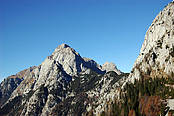History
The historical details contained in this brief text are drawn from at least three thousand years of recollections recorded by inhabitants of the Natisone Valleys.
There are two principal themes running through the history of this area: the road and the boundary. The Natisone Valleys have provided a link between the Friulian plain and the Danube basin, or, more generally, between Italy and Central Europe, affording passage to merchants, pilgrims, soldiers, and people of all races and tongues. But for long centuries the natural barrier of the mountains formed a borderland, a zone of division, hostility and defence.
The Romans constructed a paved road passing through the Natisone Valleys towards the Isonzo valley and other Alpine passes, and subsequently used by invading barbarian armies from Central-Eastern Europe.
The Longobards developed an administrative system for the Valleys, known as the gastaldia (an administrative office of the king), which was based in Antro and headed by a gastaldo, who reported directly to the central authority.
During its long history the Patriarchate (1077-1420) was marked by struggles and conflict involving the nobles and the castles of the Valleys, and it employed a unique administrative system for justice and the affairs of state. In fact, courts of justice dealing with crimes of personal injury already existed at Antro and Merso , while vicinie (councils of the village family heads) and arenghi (assemblies of the deans of the vicinie) administered the affairs of state.
The Venetian Republic (1420-1797) acknowledged the ancient arrangements and privileges of Schiavonia (as the Natisone Valleys were known on account of the Slovenian population) and granted it greater autonomy. The vicinie, and the arenghi of the Antro and Merso valleys, and the arengo grande (the general assembly of the valleys’ deans) which held session at the Church of San Quirino, provided an actual form of participatory administration.
The old institutions resisted change for many years, but French rule between 1805 and 1813 imposed reforms upon the local administrations and the judicial system, with the institution of local councils and new courts. Austria endorsed the French administrative arrangements, and turned a deaf ear to requests from mayors and citizens for a return to the old systems. The Slovenes of Natisone retaliated by supporting and joining the struggle for liberation from Austrian rule (the Risorgimento).
In 1914 news of the first movements of Italian troops towards our valleys emerged. They stationed themselves at the bottom of the valleys and in the mountains early in 1915, and began digging trenches and opening roads. In the early hours of May 24 the bersaglieri (members of a specialised infantry unit) were seen setting off from San Pietro towards Caporetto.
The First World War had begun. It was to be a long conflict in which the people suffered great hardship, and many young people died on various front lines. On October 24 1917 the mountains were shaken by powerful explosions and illuminated by sinister glows.
By 1933 the cave Masses were no longer celebrated in the Slovenian language, and Don Cramaro and Don Cuffolo began to preach in Italian under orders from the violent regime of Mussolini, who was, some years later, to lead Italy into the abyss of the Second World War (1940-1945). On this occasion we were far from the front, but there was no end to news of fallen combatants, bloody battles, bombardments, civilian victims and deportations. Unfortunately the Natisone Valleys did not escape these horrors.







